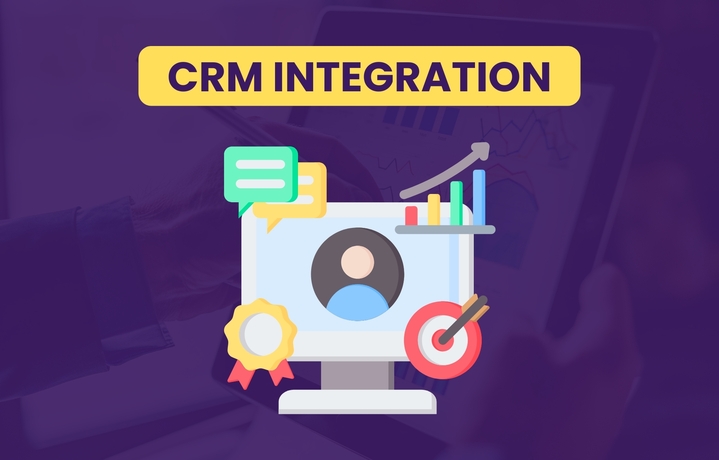Call or WhatsApp +923000113866
Email us: info@vamatters.com
"Content marketing is a powerful strategy for lead generation. By creating valuable, engaging content, businesses can attract and convert potential customers into qualified leads."
Discover how CRM integration can streamline your business operations and boost efficiency
CRM Integration: Connecting Your Tools for Maximum Efficiency
Introduction
In today’s fast-paced business world, efficiency is key. Businesses use a wide range of tools to manage customer relationships, sales, marketing, and operations, but having all of these systems working independently can create silos and inefficiencies. That’s where CRM integration comes in. By connecting your Customer Relationship Management (CRM) system with the other tools your business relies on, you can streamline operations, improve data flow, and ultimately boost productivity.

What is CRM Integration?
CRM integration is the process of connecting your CRM system with other software applications or tools that your business uses, such as marketing platforms, customer service tools, e-commerce systems, accounting software, and more. This integration allows data to flow freely between systems, providing a unified view of customer information and making it easier to manage your business operations from a single point of access.
When done correctly, CRM integration eliminates the need for manual data entry, reduces the risk of errors, and ensures that all departments within your business are working with the most up-to-date information.

Content marketing is a powerful tool for lead generation, seamlessly blending valuable information with strategic promotion to attract and engage potential customers. By creating and sharing relevant, high-quality content, businesses can draw in a targeted audience, nurture their interest, and guide them through the sales funnel. This approach not only builds trust and authority but also encourages prospects to take action, converting them into qualified leads.
1. Creating Valuable Content
Benefits of CRM Integration
Streamlined Data Flow One of the biggest advantages of CRM integration is that it ensures a smooth flow of data between systems. When your CRM is connected to other tools, customer data, sales figures, marketing insights, and service tickets all sync in real time. This gives your teams immediate access to the information they need to make informed decisions.
Increased Efficiency Integrating your CRM with other tools eliminates the need for repetitive tasks like manual data entry and data migration between systems. This automation not only saves time but also reduces the chances of errors, allowing your team to focus on higher-value tasks like nurturing leads and closing sales.
Improved Customer Experience A well-integrated CRM system provides a 360-degree view of your customers, from their first interaction with your business to ongoing support and purchases. This holistic view enables personalized and responsive customer service, as your team can quickly access relevant information from any department, ensuring consistent and tailored interactions.
Enhanced Reporting and Analytics By integrating your CRM with other platforms, such as marketing and sales tools, you gain access to comprehensive data that can help inform better decision-making. When all your tools are connected, you can generate detailed reports that give insights into customer behavior, sales trends, and marketing performance, helping you refine your strategy for maximum impact.
Better Team Collaboration Integration allows your departments—whether it’s sales, marketing, or customer support—to work more collaboratively. By having access to the same up-to-date customer information, all teams can work towards common goals with fewer communication gaps. This cross-functional collaboration leads to more cohesive strategies and better customer outcomes.

At the heart of content marketing is the creation of valuable, informative, and engaging content tailored to the needs and interests of your target audience. This can include blog posts, articles, eBooks, whitepapers, videos, podcasts, infographics, and more. High-quality content helps to establish your business as a thought leader in your industry, build trust with your audience, and address their pain points and questions. When potential customers find your content useful, they are more likely to provide their contact information in exchange for access to premium content or updates, generating leads.
2. Optimizing for SEO

Search Engine Optimization (SEO) is crucial in making your content discoverable by your target audience. By optimizing your content with relevant keywords, meta descriptions, and high-quality backlinks, you increase the chances of your content ranking higher in search engine results pages (SERPs). High visibility in search results drives organic traffic to your site. As more visitors find your content through search engines, you have more opportunities to convert these visitors into leads through strategic calls-to-action (CTAs) and lead capture forms.
3. Leveraging Social Media

Social media platforms are powerful channels for distributing your content and reaching a broader audience. By sharing your content on platforms like Facebook, LinkedIn, Twitter, and Instagram, you can engage with your followers, encourage shares, and increase your content's reach. Social media also allows for targeted advertising, enabling you to promote your content to specific demographics, interests, and behaviors. Engaging content on social media can drive traffic back to your website, where you can capture leads through gated content, CTAs, and landing pages.
4. Implementing Lead Magnets

Lead magnets are valuable resources offered to potential customers in exchange for their contact information. Examples include eBooks, whitepapers, checklists, webinars, free trials, and exclusive access to industry reports. By gating these valuable resources behind a lead capture form, you incentivize visitors to provide their email addresses and other contact details. Lead magnets not only help you gather leads but also demonstrate your expertise and value, increasing the likelihood of converting these leads into customers.
5. Nurturing Leads with Email Marketing

Once you have captured leads, email marketing is an effective way to nurture them through the sales funnel. By sending targeted and personalized email campaigns, you can provide additional value, keep your brand top-of-mind, and move leads closer to making a purchase decision. Email content can include newsletters, product updates, personalized offers, educational content, and more. Automation tools can help segment your audience and deliver the right content at the right time, enhancing the lead nurturing process.
6. Utilizing Analytics and Insights

Analytics and insights are essential for measuring the effectiveness of your content marketing efforts and making data-driven decisions. By tracking metrics such as website traffic, bounce rates, time on page, conversion rates, and lead quality, you can assess which content pieces are performing well and which areas need improvement. Tools like Google Analytics, social media analytics, and marketing automation platforms provide valuable data to refine your strategies, optimize content, and improve lead generation outcomes.
7. Engaging with Interactive Content

Interactive content, such as quizzes, surveys, calculators, and interactive infographics, can significantly enhance user engagement and lead generation. This type of content encourages active participation from your audience, making the experience more memorable and personalized. Interactive content often requires users to input information, which can be used to capture leads and gather valuable data about their preferences and needs. Additionally, interactive content can be highly shareable, increasing your reach and attracting more potential leads.
8. Building Strategic Partnerships

Collaborating with influencers, industry experts, and other businesses can amplify your content marketing efforts and generate more leads. By partnering with individuals or organizations that have a large and engaged audience, you can tap into their follower base and extend your reach. Guest blogging, co-hosting webinars, and cross-promoting content are effective ways to leverage strategic partnerships. These collaborations can introduce your brand to new audiences, build credibility, and drive traffic to your lead capture pages.
How VA Matters Can Help with CRM Integration
At VA Matters, we understand that every business has unique needs, which is why we take a tailored approach to CRM integration. Our team works closely with you to assess your existing systems and identify opportunities for integration that will provide the most value to your business.
Here’s how we support you through the process:
Customized Integration Solutions We evaluate your current tools and CRM system to identify the most efficient ways to connect them. Whether you’re looking to integrate email marketing, accounting software, or customer support tools, we ensure a smooth integration process that aligns with your business goals.
Expert Technical Support Our team of CRM experts manages the technical aspects of integration, ensuring that your systems work together without disruption. We handle everything from system setup to troubleshooting, so you can focus on running your business
Enhanced User Training To ensure your team gets the most out of your integrated CRM, we provide in-depth training and resources. This enables your staff to use the new system effectively and maximize the benefits of the integration.
Conclusion
CRM integration is a game-changer for businesses looking to improve efficiency, enhance collaboration, and deliver superior customer experiences. By connecting your CRM with other essential tools, you can unlock the full potential of your systems, reduce redundancies, and make data-driven decisions that drive growth.
At VA Matters, we’re committed to helping your business achieve maximum efficiency through seamless CRM integration. Contact us today to learn how we can tailor a solution that meets your needs and sets your business up for long-term success.

Subscribe to our social
We’re on a mission to build a better future where technology creates good jobs for everyone.
© Copyright 2024. VA Matters (SMC-PRIVATE) Limited. All rights reserved.




